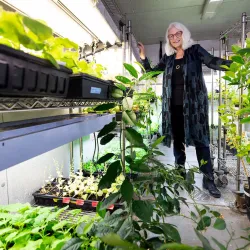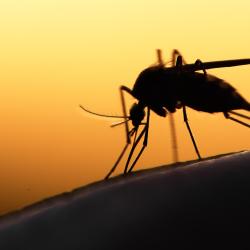Big Questions In Science- 3) How can deadly pathogens be controlled?
Deadly pathogens infecting human cells are all in a day’s work for Associate Professor Najib El-Sayed in the Department of Cell Biology and Molecular Genetics and the University of Maryland Institute for Advanced Computer Studies (UMIACS). Under carefully controlled conditions in his campus laboratory, El-Sayed grows three related trypanosomatid parasites that afflict an estimated 20 million people worldwide, causing diseases that run rampant in the developing world, including African sleeping sickness and Chagas disease.
Through his research, El-Sayed exposes these parasites to human cells grown in the laboratory and examines what happens on a genomic level. “We’re looking to see how the parasite adapts to the host and how it interferes with the host’s defense mechanisms,” says El-Sayed, whose research is funded by the National Institute of Allergy and Infectious Diseases of the National Institutes of Health. “Ultimately, our goal is to help scientists develop drug targets or vaccines.”
As an undergraduate biology student, El-Sayed was fascinated by parasites. “They have complex, amazing lifecycles that take them from one host to another with incredible ways of modulating the function of every host and changing it to optimize their survival,” he notes. That’s great for parasites, but it could be lethal for host sites, including humans.
Today, El-Sayed’s research utilizes next-generation sequencing technology to follow every single one of a parasite’s 10,000 genes and examine how each gene behaves during the infection process. Likewise, he studies how the host cell responds. “We’re trying to understand their gene expression programs, which genes turn on and off,” he explains.
In a major breakthrough, the team recently identified a subset of genes in the Chagas disease-causing Trypanosoma cruzi parasite that activates when the pathogen is about to enter the human cell. “That finding tells us these genes must be involved in the infection process,” says El-Sayed. Further research indicated that the products of a subset of these genes, the Mucin-Associated Surface Proteins (MASP), play key roles in the infection process.
Using bioinformatics tools, the researchers then identified a set of proteins in the human host that interacts with MASP. “We theorized that if we could stop that interaction, we could reduce the infection rate of Chagas disease,” explains El-Sayed. Spread by the bite of triatomine (kissing) bugs, Chagas disease is a major health problem in South and Central America. Left untreated, about 30 percent of infected individuals develop chronic symptoms, including potentially fatal digestive and heart problems.
Back in the lab, El-Sayed’s team has successfully prevented human cells from expressing the pinpointed proteins. “Suddenly the infection rate was reduced dramatically,” says El-Sayed, who hopes his work leads to new treatments for a number of life-threatening diseases. “More than one-fifth of the world’s population live in areas inhabited by the insects that transmit these parasites,” says El-Sayed. “There’s a pressing need to find drugs and vaccines for these neglected diseases.
Writer: Beth Panitz







